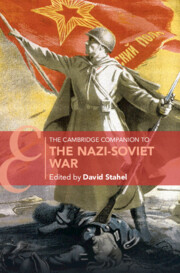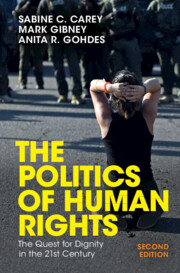Refine search
Actions for selected content:
273 results
8 - Human Rights
- from Part III - Peace and War
-
- Book:
- Politics and International Law
- Published online:
- 23 December 2025
- Print publication:
- 22 January 2026, pp 253-297
-
- Chapter
- Export citation
11 - Criminal Responsibility
- from Part IV - New Challenges
-
- Book:
- Politics and International Law
- Published online:
- 23 December 2025
- Print publication:
- 22 January 2026, pp 383-418
-
- Chapter
- Export citation
Palestine is a Paradigm
- Part of
-
- Journal:
- Public Humanities / Volume 1 / 2025
- Published online by Cambridge University Press:
- 10 December 2025, e179
-
- Article
-
- You have access
- Open access
- HTML
- Export citation
Chapter 7 - Rwanda
- from Part II - Separate Paths
-
- Book:
- Historical Trauma
- Published online:
- 20 November 2025
- Print publication:
- 04 December 2025, pp 178-212
-
- Chapter
- Export citation
14 - Soviet Crimes at Times of War, 1941–1945
- from Part IV - Criminality and Occupation
-
-
- Book:
- The Cambridge Companion to the Nazi-Soviet War
- Published online:
- 13 November 2025
- Print publication:
- 20 November 2025, pp 248-262
-
- Chapter
- Export citation

The Cambridge Companion to the Nazi-Soviet War
-
- Published online:
- 13 November 2025
- Print publication:
- 20 November 2025

The Politics of Human Rights
- The Quest for Dignity in the 21st Century
-
- Published online:
- 12 November 2025
- Print publication:
- 06 November 2025
-
- Textbook
- Export citation
Chapter 5 - Context of Human Rights Violations
- from Part II - Explaining Human Rights Violations
-
- Book:
- The Politics of Human Rights
- Published online:
- 12 November 2025
- Print publication:
- 06 November 2025, pp 144-171
-
- Chapter
- Export citation
Palestinian Workers in the West Bank: Labor in the Time of Genocide
-
- Journal:
- International Labor and Working-Class History , First View
- Published online by Cambridge University Press:
- 04 November 2025, pp. 1-7
-
- Article
-
- You have access
- Open access
- HTML
- Export citation
6 - Why Are Indigenous Women and Girls Missing and Murdered?
- from Part II - Learning from Women of Color
-
- Book:
- Justice, Equity, Diversity, and Inclusion in the United States
- Published online:
- 19 November 2025
- Print publication:
- 30 October 2025, pp 125-144
-
- Chapter
-
- You have access
- Open access
- HTML
- Export citation
Social Reproduction as Survival and Insurgency in Gaza
-
- Journal:
- International Labor and Working-Class History , First View
- Published online by Cambridge University Press:
- 08 October 2025, pp. 1-5
-
- Article
-
- You have access
- Open access
- HTML
- Export citation
5 - Politics of Revolution
-
- Book:
- Latin America and Human Rights Politics in West Germany, 1973–1990
- Published online:
- 18 October 2025
- Print publication:
- 18 September 2025, pp 183-222
-
- Chapter
- Export citation
5 - Into the Vortex
-
- Book:
- Epochal Crisis
- Published online:
- 21 August 2025
- Print publication:
- 04 September 2025, pp 180-214
-
- Chapter
- Export citation
Recent developments in reliance upon third-party fact-finding at the International Court of Justice
-
- Journal:
- Leiden Journal of International Law / Volume 38 / Issue 3 / September 2025
- Published online by Cambridge University Press:
- 13 August 2025, pp. 617-640
-
- Article
-
- You have access
- Open access
- HTML
- Export citation
Did the ICJ Act Ultra Vires? The Orders on the Convention on the Prevention and Punishment of the Crime of Genocide in the Gaza Strip
-
- Journal:
- Israel Law Review , First View
- Published online by Cambridge University Press:
- 07 August 2025, pp. 1-26
-
- Article
-
- You have access
- Open access
- HTML
- Export citation
Chapter 6 - Landscapes of Memory
-
- Book:
- Healing and the Invention of Metaphor
- Published online:
- 17 July 2025
- Print publication:
- 31 July 2025, pp 146-174
-
- Chapter
- Export citation
9 - Entanglements
- from Part IV - (Dis)Connected Pasts
-
- Book:
- Fractured Pasts in Lake Kivu’s Borderlands
- Published online:
- 17 July 2025
- Print publication:
- 31 July 2025, pp 272-308
-
- Chapter
- Export citation
Chapter 14 - Enforcement of international law
-
- Book:
- International Law
- Published online:
- 26 July 2025
- Print publication:
- 31 July 2025, pp 766-795
-
- Chapter
- Export citation
12 - International Legitimacy and Rightful Conduct
- from Part IV - Construction of Legitimacy in International Law
-
- Book:
- The Law and Politics of International Legitimacy
- Published online:
- 14 July 2025
- Print publication:
- 24 July 2025, pp 226-241
-
- Chapter
- Export citation

Fractured Pasts in Lake Kivu’s Borderlands
- Conflicts, Connections and Mobility in Central Africa
-
- Published online:
- 17 July 2025
- Print publication:
- 31 July 2025
